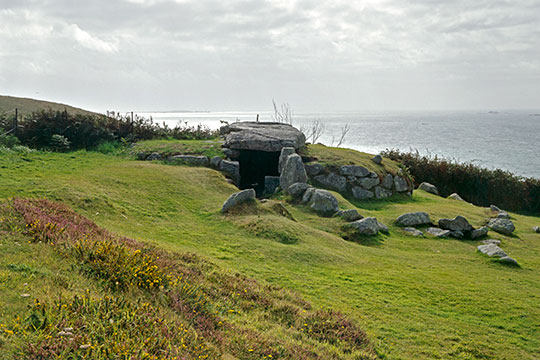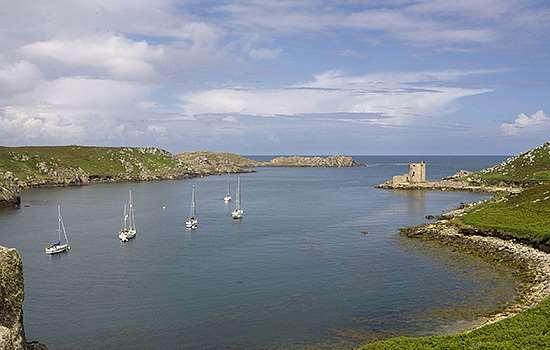History of Bant’s Carn Burial Chamber and Halangy Down Ancient Village
Bant’s Carn, a Bronze Age tomb of the type known as an entrance grave, sits on the crest of a hill on the island of St Mary’s, in the Isles of Scilly. On the slopes below lie the remains of an Iron Age settlement that continued in use for about 500 years until the end of the Roman period.

There is evidence of extensive and permanent settlement on the Isles of Scilly from around 2500 BC. At that time the sea level was lower and much of Scilly formed a single landmass.
Throughout later prehistory the sea level continued to rise, and it was probably not until the early medieval period that the islands took the form we see today. In the middle Bronze Age, when the burial cairns were built, the sea had already mostly flooded the productive farmlands that presumably occupied the sheltered valleys and flatter lands between the present islands.
Bant’s Carn burial chamber
About 80 stone structures known as entrance graves are recorded from this period on the Isles of Scilly. Such a concentration in a small area is very unusual, and Bant’s Carn is one of the finest of these monuments.
Bant’s Carn consists of an outer platform surrounding an inner cairn or mound containing a slab-built chamber. The mound is about 26 feet (8 metres) long and 20 feet (6 metres) wide, retained by a well-made kerb of stone slabs; a second kerb retains the lower platform around the mound.
The mound may once have been more than 13 feet (4 metres) high, so that it would have entirely covered the boat-shaped, stone-lined burial chamber whose roof is now exposed.
The chamber itself, 17 feet (5.25 metres) long by 5 feet (1.5 metres) wide, is much higher than most other entrance graves – up to 5 feet (1.5 metres) in places – and is roofed with four enormous capstones. A stone-lined entrance passage, now roofless, leads from the outer kerb to the entrance of the burial chamber.
Bant’s Carn was excavated in 1900, but was found to be almost empty. At the far end of the burial chamber four piles of cremated human bones were discovered, together with a few fragments of decorated pottery.
Most of these were probably from the urns in which the remains of the dead had originally been placed, but one was part of a shallow bowl, much older than the rest and perhaps dating back to the time of the very first settlers. More pottery of a similar kind was discovered in 1970 during the re-erection of a fallen capstone.
The Purpose of Entrance Graves
The high number and concentration of entrance graves found on the Isles of Scilly have led some archaeologists to suggest that the practice of communal burial may have continued much longer here than on the mainland.
It may be that fewer examples have survived on the mainland because land was in short supply.
It has also been suggested that these monuments may have acted as territorial markers, signifying ancestral ownership: many of them, like Bant’s Carn, stand close to prehistoric field systems that were already in existence when the mounds were built.
Other Scillonian entrance graves in the care of English Heritage can be seen at Innisidgen and Porth Hellick Down on St Mary’s.
Halangy Down Ancient Village
The later Iron Age to Roman settlement lies below Bant’s Carn at the south-west edge of Halangy Down. Between the two and on the slope to the north-east, traces of prehistoric field systems are visible as a series of terraces and banks, generally following the contours of the slopes.
Some of the stone slabs used to retain the terraces can still be seen, and individual terraces survive to a length of about 330 yards (300 metres). The banks intersecting the terraces and running down some parts of the Halangy Down slope are later modifications that created smaller rectangular field plots.
The Iron Age and Romano-British inhabitants of the settlement here probably lived in much the same way as their Bronze Age predecessors.
The Village Houses
Excavation in the 1950s revealed a complex of 11 interconnecting stone-built houses, most of them simple oval structures.
Post holes show that each house had its own conical thatched roof; there were stone-lined drains, and stores or cupboards constructed within the thickness of the walls.
One house, larger than the rest, was built on the courtyard pattern characteristic of the surviving Romano-British villages on the mainland in west Cornwall, good examples of which are Carn Euny and Chysauster. These houses are arranged with various rooms leading off a small courtyard, all contained within a massive enclosing wall and entered via a narrow passage. The house at Halangy Down is 90 feet (27 metres) long by up to 48 feet (14.5 metres) wide, with three rooms and a long, curved entrance passage.
All the houses showed signs of repair and alteration, suggesting that the settlement had a long and vigorous life. Excavations at the site produced many artefacts and showed that the inhabitants practised a mixed economy, farming cattle, sheep, pigs and horses.
Apart from a few scraps of Samian ware – glazed red pottery imported from southern Gaul – there was little sign of contact with the outside world. Despite living through the rise and fall of the Roman Empire, the people of Halangy Down had little reason to be concerned with events across the sea.
The Cemetery
The inhabitants of this later settlement appear to have been buried individually, rather than in large collective tombs like Bant’s Carn.
West of the Halangy Down settlement is a cemetery of small funerary chambers called cists, of a form typical of the Romano-British period in Scilly.
Further Reading
Ashbee, P, ‘Bant’s Carn, St Mary’s, Isles of Scilly: an entrance grave restored and reconsidered’, Cornish Archaeology, 15 (1976), 11–26
Ashbee, P, ‘Excavations at Halangy Down, St Mary’s, Isles of Scilly, 1969–70’, Cornish Archaeology, 9 (1970), 69–7
Grey, A and Ashbee, P, ‘Prehistoric habitation sites on the Isles of Scilly’, Cornish Archaeology, 11 (1972), 19–49
Sawyer, K, Isles of the Dead?: The setting and Function of the Bronze Age Chambered Cairns and Cists of the Isles of Scilly (Oxford, 2015)



